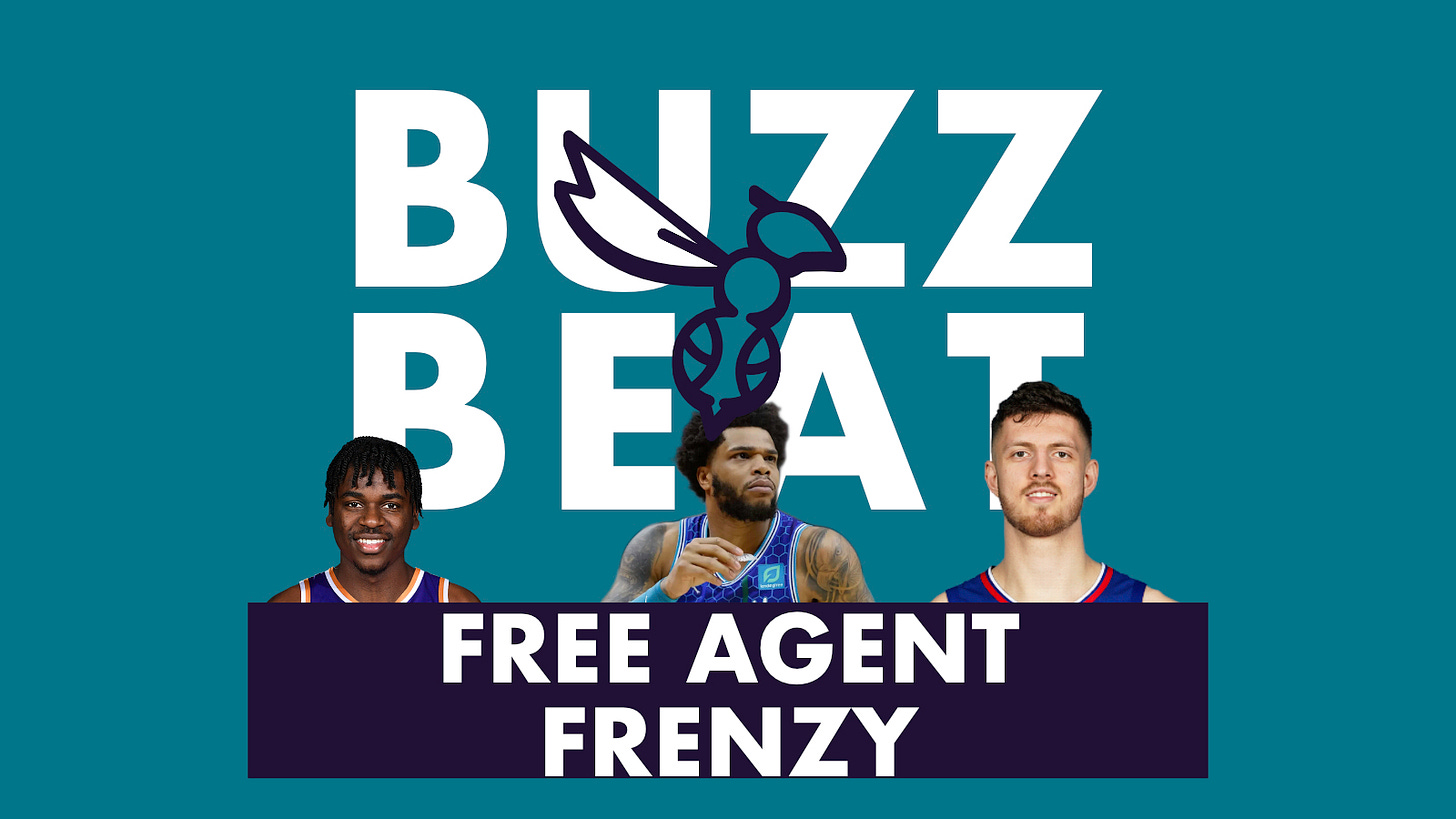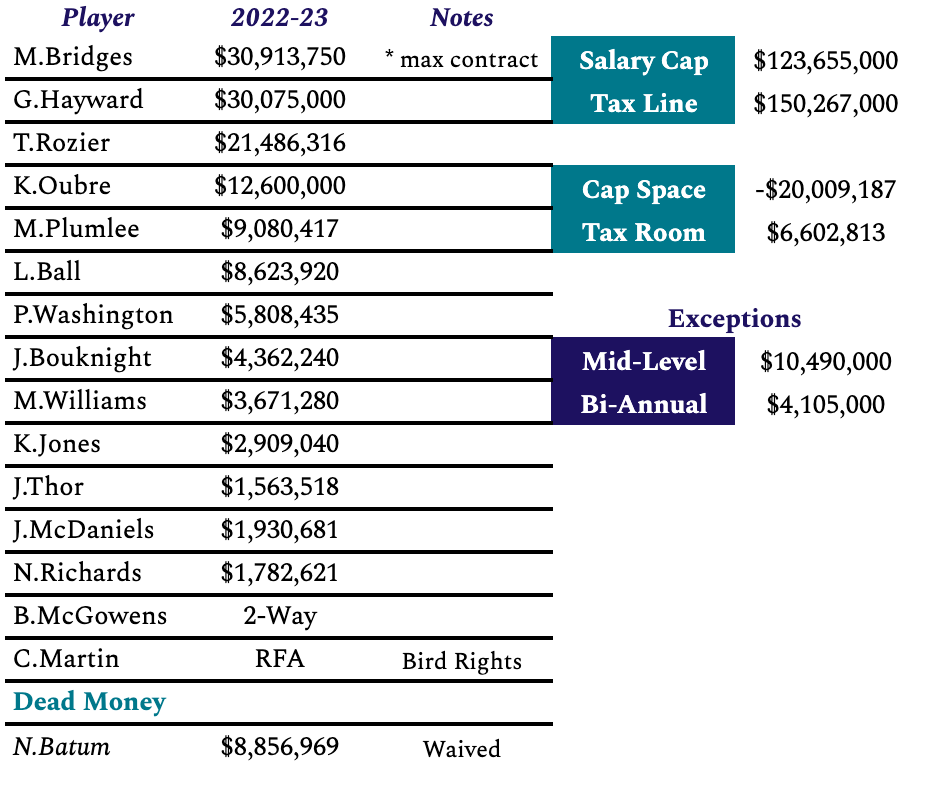Good Morning! The NBA Draft is behind us and we look forward to the constant shifting and dominoes that is NBA Free Agency. I wanted to give a shout-out to mcley_Ma on Twitter, otherwise known as Buzz Beat’s resident cap consultant. He’s a must-follow for nuggets about the salary cap and I even ran a couple of things by him before letting today’s newsletter fly. Let’s dig in!
Note: This was written and published before the news broke about Miles Bridges last night and his arrest for domestic abuse. Almost everything in this piece is still relevant.
📅 Key Dates
Thursday, June 30: At 6 pm EST, players can start negotiating with teams. As the moments and days pass, we get indications – usually through Adrian Wojnarowski and Shams Charania – where free agents will land. Although, nothing is official until the moratorium is over.
Wednesday, July 6: At 12 pm EST, the moratorium period ends and you will start to see official news from teams that they’ve signed free agents. For restricted free agents, teams have 48 hours to match any opposing offer sheet, and that clock starts on this date, not prior.
📝 Key Terms
Maximum Contract: The NBA has parameters on how much a player can earn, with not all having the ability to make whatever they demand. Experience in the league is the biggest indicator of how much one can receive. The NBA separates players into three different categories: (1) 0-6 years, (2) 7-9 years, and (3) 10+ years.
For example, Miles Bridges has been in the league for 4 seasons and because of that, can receive a starting salary of 25% of the cap ($123.6 million x 0.25 = $30.9 million). If a player had been in the league for 7-9 seasons, his starting salary would be 30% of the cap. Once a player makes it to 10+ years, they can have a starting salary of 35% of the cap. But remember, just because someone can receive the maximum contract, it doesn’t mean they will. It’s still a negotiation.
Restricted Free Agent: Free agents either fall under unrestricted or restricted. There are more complications with restricted free agents, so I figured I’d discuss that here. Teams that possess restricted free agents have the “first right of refusal” allowing them to match offers from other teams. If an opposing team agrees to an offer sheet with a player, the original team has 48 hours to make their decision. If that team doesn’t exercise that power, then the player will move on to the new team. There’s technically another option, although rare and risky. The restricted free agent could sign his qualifying offer – one that must’ve been submitted for him to become restricted in the first place – and play out the season on that one-year deal. Following that one-year contract, the player would then become an unrestricted free agent the following summer.
The Hornets’ Situation
The Hornets have some big decisions to make this offseason on some of their own free agents. Miles Bridges and Cody Martin headline the list and both will require a pay increase. Bridges has drawn interest from around the league and some believe he’ll be able to get his max of $30.9 million. Luckily, Charlotte has the ability to match and, if they wanted to, offer more than any other team. Martin was also extended a qualifying offer from the team and is now a restricted free agent.
The projected cap for the 2022-23 season is $123,655,000. The projected tax line would be just north of $150 million – a number that many will need to pay attention to. The luxury tax is a mechanism to penalize teams for overspending. If Charlotte did nothing else and signed Miles Bridges to a maximum contract, starting at $30.9 million, they would still be roughly $6 million below the tax threshold.1
In addition to Bridges and Martin, Montrezl Harrell and Isaiah Thomas are also free agents.
No Space, What’s Next?
Even though the current salaries on the Hornets’ books exceed the salary cap of $123.6 million, that doesn’t prevent Charlotte from acquiring players. Firstly, both Bridges and Martin qualify for the “Larry Bird” exception because they’ve played on the team for three consecutive seasons. With “Bird rights,” a team can sign its own free agent and still exceed the cap.
Mitch Kupchak let it slip during Steve Clifford’s introductory press conference that they will be bringing back Bridges. While you can never say never, this is certainly what most would’ve expected. The Detroit Pistons, once linked to Bridges, just lost a good chunk of their space by absorbing $19 million in a trade for Nerlens Noel and Alec Burks. While other teams have been rumored to be after the 24-year-old forward, there’s been recent hints that Bridges might not even receive that max offer sheet from an opposing team. If that’s the case, Kupchak can negotiate a deal without having to reach $30 million. Remember, Charlotte can provide him that 5th year and up to 8% raises – something that other teams just couldn’t accomplish.
Even when the Hornets inevitably exceed the cap, there are other exceptions that allow them to bring in free agents. The likely avenue is through something called the non-taxpayer mid-level exception (MLE). This would be available to the Hornets as they are over the cap but under the tax. This year, that exception is worth $10,490,000 and can be used to sign a free agent. However, once a team uses even part of this exception, it has to keep itself below a hard cap for the whole season. The estimated number for that hard cap is $156,983,000 for the 2022-23 season. The calculation method to determine whether a team is below the hard cap is slightly different than the team salary calculation, but you can use the latter as an approximation. As an aside, the MLE can be split among two players, if a team desires.
There are so many machinations that the Hornets can take in free agency, but a lot of it will depend on how much Miles Bridges signs for and the tax room they have remaining. Before getting out of here, let’s take a look at some practical targets that could help shore up the roster.
🎯 Potential Targets
Let me preface this: I’m poor at predicting the contracts of free agents. It’s not that I don’t know the on-court worth of some of these players, it’s because there are so many variables in an open market. Having said that, I’m going to make sure I keep it within reason – even if said player signs more than anticipated. In no particular order, let’s take a look at four free agents that could be on the radar.
Delon Wright, Guard, 30 years old (UFA)
Delon Wright split time at both guard positions with Atlanta last season. Charlotte, in need of a backup point guard, could take the route of acquiring a combo guard to fill that hole.
One of the more appealing things about Wright is his defense. His length and anticipation allowed him to create disruption with deflections and jump passing lanes as an off-ball defender. He also has some versatility in who he can guard; he defended more than just the point guard position. He’s also able to do this without fouling (1.9 fouls/100 possessions) — an underrated skill. Offensively, Wright looks to get to the rim or drive and kick, which fits right in with how the Hornets want to play. From behind the arc, he shot 38.5%.
Aaron Holiday, Guard, 25 years old (UFA)
Hornets have a thing for acquiring brothers in the NBA (Plumlee, Ball, McDaniels, Martin, Zeller), so we might as well continue the tradition with Aaron Holiday. Holiday, although younger, should be viewed as a step or two down from Delon Wright.
Holiday has some on-ball chops in terms of how he likes to play. He’s not going to be used much as an off-ball mover and prefers the pull-up shot. As a driver, if he’s not getting all the way to the rim, he has a liking for that running floater. Despite being just 6 feet, he’s been passable on the defensive end of the court. Last season with the Wizards and Suns, he had a 2.0 steal% – the highest of his career.
Isaiah Hartenstein, Big, 24 years old (UFA)
The Hornets have an excess of centers, and unless they get off of Mason Plumlee, it seems as though backcourt depth would prove to be higher on the pecking order. Having said that, Hartenstein would be a solid addition that could help mentor Mark Williams.
The lefty center uses his size well as a hub at the top of the key and as a roller. He does an awesome job of sealing the man he’s screening, giving him or potential drivers space in the lane. He also has the skill and eye level to pass over the top of defenders to teammates on basket cuts. He produced 11.4 assist points per 75 possessions this past season, a very good number for a 7-footer. He can do a little bit of everything and his outside shooting is one to keep an eye on. He doesn’t have the volume that instills total confidence, but he did shoot 14 of 30 on three-point attempts in 2021-22.
Defensively, he can play in a drop scheme but is also nimble enough to come up to the level. His size, shot contests, and blocking are all very high-level and would do wonders for Charlotte’s backline defense.
Josh Okogie, Wing, 23 years old (UFA)
It seems as though Okogie wasn’t extended a qualifying offer from Minnesota, making him unrestricted. If you’re chasing him, you’d solely be selling yourself on his defense. I’m lukewarm on this potential target for Charlotte, but I could see the appeal under Clifford. He can comfortably guard positions 1 through 3, with the occasional matchup against a power forward. He’s going to get his hands in the passing lanes — 2.4 steal% — and start transition offense. This was a staple in the way the Hornets operated.
On the flipside, Okogie is very limited on the offensive end of the court and some might start having flashbacks to Michael Kidd-Gilchrist. The hope would be that the coaching staff could extract some value by using him as an off-ball cutter and a roll man out of the pick-and-roll. Although, if teams don’t respect him from the outside, he might be limited in the lineups he can play with.
🐝 Oh, and Kemba Walker when he gets waived from Detroit. I certainly wouldn't be shocked if that happened, but also think his return to the Queen City wouldn’t be as fruitful as many fans would hope. He’d be more of a lockerroom voice than anything. That’s it for now!
At the time of publishing this piece, Kelly Oubre’s $12.6 million contract was still guaranteed. If Charlotte wanted to save $7.6 million, they could waive Oubre today (June 30) and just be on the hook for $5 million. Other note: Nick Richards’ contract becomes fully guaranteed on July 7.





